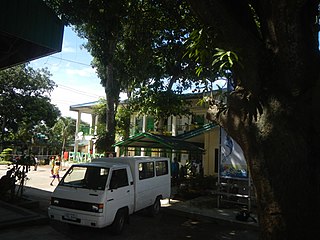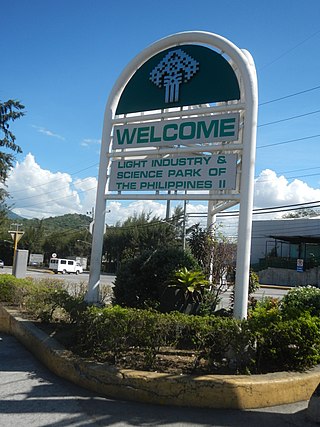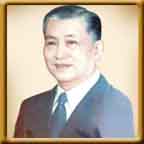
Tagaytay, officially the City of Tagaytay, is a 2nd class component city in the province of Cavite, Philippines. According to the 2020 census, it has a population of 85,330 people.

Calamba, officially the City of Calamba, is a 1st class component city in the province of Laguna, Philippines. According to the 2020 census, it has a population of 539,671 people.

Santa Rosa, officially the City of Santa Rosa, is a 1st class component city in the province of Laguna, Philippines. According to the 2020 census, its population was 414,812 people.

Biñan, officially the City of Biñan, is a 1st class component city in the province of Laguna, Philippines. According to the 2020 census, it has a population of 407,437 people.

Cabuyao, officially the City of Cabuyao, is a 1st class component city in the province of Laguna, Philippines. According to the 2020 census, it has a population of 355,330 people.

José Yulo was the Chief Justice of the Supreme Court of the Philippines during the Japanese Occupation and was Speaker of the National Assembly of the Philippines from 1939 until World War II started in 1941. Yulo served in all of the branches of government: the legislative as House Speaker, congressman, and senator; the executive as Secretary of Justice and member of the Cabinet; and the judiciary as the Associate Justice and Chief Justice of the Supreme Court of the Philippines. He and his family also owned the Canlubang Sugar Estate that they bought in 1948.

Punta is a rural barangay of Calamba, Laguna in the Philippines. It is situated in the central-south portion of the city.

Light Industry and Science Park (LISP) is the name of a series of industrial parks in the Philippines owned and developed by Science Park of the Philippines. It has six locations, namely: LISP I in Cabuyao, Laguna, LISP II in Calamba, Laguna, LISP III in Santo Tomas, Batangas, LISP IV in Malvar, Batangas, Cebu Light Industrial Park (CLIP) in Lapu-Lapu City, and Hermosa Ecozone Industrial Park (HEIP) in Hermosa, Bataan.

The Calamba Premiere International Park (CPIP), established in 1999, is one of the first industrial parks in the Philippines. It is a comprehensively-planned industrial estate located at Batino, Barandal, and Prinza in Calamba, Laguna and provides a workplace for technology-based, light and medium industries.

Mamatid station is a railway station located on the South Main Line in Laguna, Philippines.
Sirang Lupa, also known as Kabiserang Lupa, is a barangay in Calamba, Laguna, Philippines. It is situated adjacent to Canlubang. As of the 2020 census, Sirang Lupa had a population of 12,938.

Mayapa is an urban barangay, located to the east of Sirang Lupa and southeast of Canlubang in Calamba, Laguna, Philippines. It is next to the Mayapa-Canlubang exit of the South Luzon Expressway. As of the 2020 census, Mayapa had a population of 28,302.

Real is a barangay in the city of Calamba. It is also where the new Calamba City Hall and the Rizal Monument are located.

Paciano Rizal is an urban barangay comprising in Calamba, Laguna, in the Philippines. It is the fifth most important barangay in Calamba City. It is situated to the west of San Cristobal, to the east of Mayapa, to the north of Lawa and south of Mapagong. It is named after Paciano Rizal, who was born in this barangay, a revolutionary, and the older brother of José Rizal.
Cabuyao Mansion is a government-owned mansion located at Brgy. Casile, Cabuyao. The mansion was built in the 1980s during the administration of the former Philippine president Ferdinand Marcos. It was then sequestered in 1987 as part of the ill-gotten properties that were acquired by the Marcos family. In 2010, the Sandiganbayan ordered the return of the property to the Marcos Family. However, in 2017 the Supreme Court of the Philippines released a hold order on this, and the property is still currently under control of the Presidential Commission on Good Government.
Canlubang Golf & Country Club "This golf course is located in Luzon, approximately 5 kilometers from Terelay, situated at the base of Barangay Casile in Cabuyao, Laguna. It is recognized as one of the notable golf courses in the region. In terms of comparison, similar establishments include The Country Club in Santa Rosa and the Santa Elena Golf Course. Historically, the site of the golf course was a sugar cane plantation during the era of José Yulo. The golf course features a layout with both northern and southern courses, encompassing a total of 36 holes."
Silangan Industrial Park, also known as Canlubang Industrial Estate, is an industrial zone located at barangay Canlubang, Calamba, Laguna. It is situated at Silangan Industrial Avenue and Jose Yulo Avenue.

Mayapa–Canlubang Cadre Road, also known as Mayapa Road, is a two- to four-lane, tertiary national road, located in Calamba, Laguna in the Philippines. It spans 2.768 kilometers (1.720 mi) stretching from the "Checkpoint" area at the intersection with Manila South Road in barangay Paciano Rizal to Jose Yulo Sr. Avenue and Silangan Industrial Park Road in barangay Canlubang. This road adjoins the Canlubang Exit of South Luzon Expressway.



































